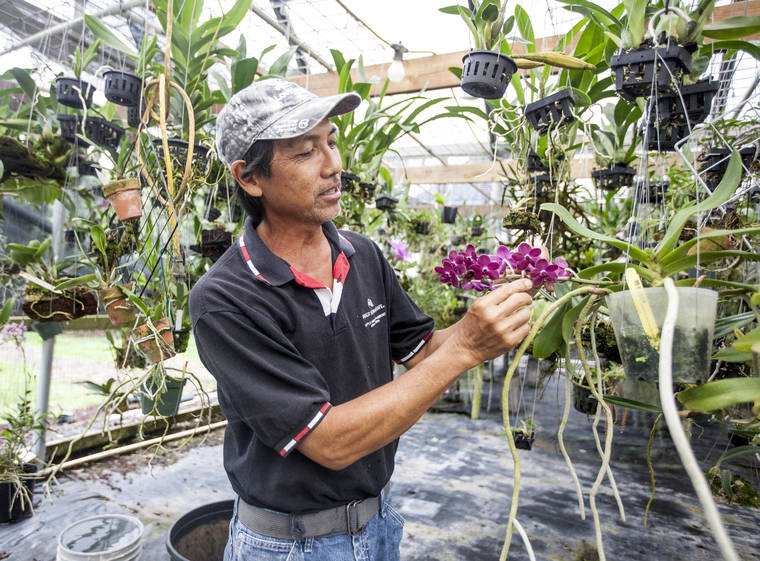Like many other nursery owners in Kapoho, Elton Mow lost years of labor when lava from the 2018 Kilauea eruption hooked around Green Mountain and buried the area under more than 60 feet of fresh rock.
Now he faces the arduous task of starting over.
“I’m restarting, but it’s a long road ahead,” said Mow, who lost 12 acres.
A survey conducted by the University of Hawaii and state Department of Agriculture found at least 46 farms affected by the eruption, with more than 1,337 acres of arable land covered. The total agricultural loss: $27.9 million, mostly from nurseries and papaya farms.
Of those surveyed, 87 percent said they wanted to restart or relocate.
That requires raising capital and having a plan to survive before generating income.
“If I survive three years, I’ll get cash coming in,” said Mow, 54.
He said he has been working part time for UH through a federal dislocated worker grant.
Some received payments from crop insurance or aid from the federal government for noninsurable crops, which was capped at $125,000, for those who qualified.
The Agriculture Department offers disaster loans with 3 percent interest, said Dean Matsukawa, the department’s loan administrator. Three loans were issued to papaya farmers for a total of $160,000, he said.
Mow said he had some crop insurance for his orchids and is trying to avoid taking out a large loan.
“I don’t want to take on a big debt, because I’m not that young anymore,” he said.
Mow, who lives in the Keaau Agricultural Lots, where he has a greenhouse, might be in a better position than most because he already leases 4 acres from W.H. Shipman and didn’t lose his home. He started leasing the land following the 2014 lava flow that threatened Pahoa and Tropical Storm Iselle, but hadn’t put it to use. That’s where he plans to restart.
“It’s like an insurance policy,” he said.
Still, the area isn’t as ideal for orchids because it tends to get more rain.
That means he has to use greenhouses instead of shade houses, which are 10 to 20 times more expensive.
“We had enough rainfall, but not too much, and lots of sunshine,” Mow said about Kapoho.
That climate is ideal for orchids and papayas.
According to the state survey, the floriculture and nursery industry lost $13.3 million because of the eruption, and papaya farmers incurred $6.5 million in losses, mostly in lost crops.
Eric Weinert, president of the Hawaii Papaya Industry Association, said lack of access to existing farms has been a problem, particularly along Highway 132. That started to change April 1 when a temporary access road through Puna Geothermal Venture was opened to an isolated kipuka.
Weinert said a few papaya farmers relocated to Keaau, but they face the same problem with the climate as flower growers.
“It’s pretty wet up there,” he said.
Farmers who restart have to wait a year before they can begin harvesting, Weinert said.
Weinert and Eric Tanouye, Hawaii Floriculture and Nursery Association president, both said the disaster has left the demand for their products unmet, causing customers to seek supply from other countries.
“The market will be purchasing foreign product,” Tanouye said, if demand can’t be met locally. “That is a big concern.”
About 25 farms that were destroyed also have loans totaling $2.5 million through the state, Matsukawa said.
He said the loans haven’t been forgiven, though payments have been deferred.
Gregg Adams, whose dragon fruit and palm farm was inundated off Highway 132, said he has a $50,000 loan from the state, but didn’t see the deferral as providing much help since it only applies to the principal.
He doesn’t have access to his property and can’t attempt to restart until the county builds at least a temporary road over the highway. Adams said he can’t access his property through the PGV site.
He said he was expecting more help from the state or federal governments, adding it’s been a “very painful process.”
“I can’t help but feel abandoned,” Adams said. “I don’t see a lot of assistance.”
Email Tom Callis at tcallis@hawaiitribune-herald.com.




